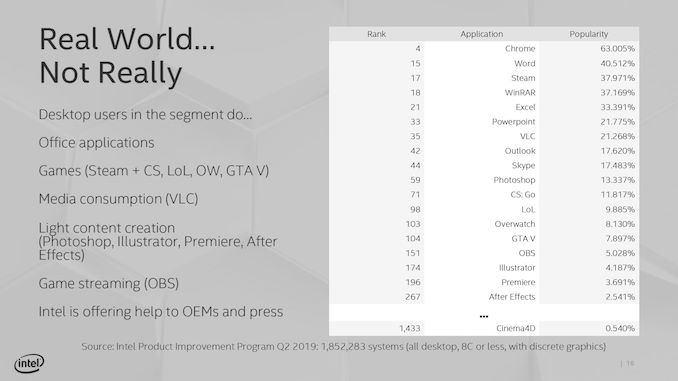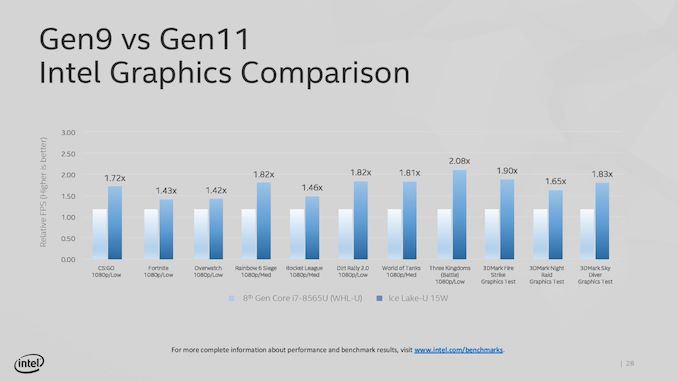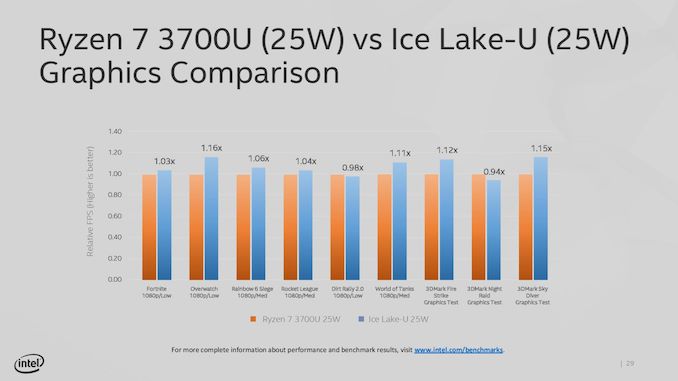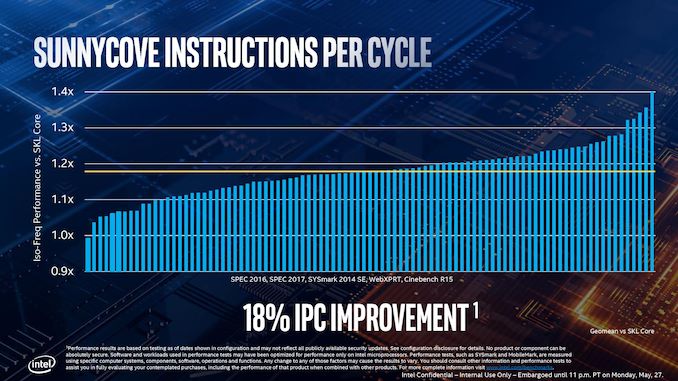Examining Intel's Ice Lake Processors: Taking a Bite of the Sunny Cove Microarchitecture
by Dr. Ian Cutress on July 30, 2019 9:30 AM EST- Posted in
- CPUs
- Intel
- 10nm
- Microarchitecture
- Ice Lake
- Project Athena
- Sunny Cove
- Gen11
Performance Claims:
+18% IPC vs. Skylake,
+47% Performance vs. Broadwell
With every new product generation, the company releasing the product has to put some level of expectations on performance. Depending on the company, you’ll either get a high level number summarizing performance, or you’ll get reams and reams of benchmark data. Intel did both, especially with a headline ‘+18%’ value, but in recent months the company has also been on a charge about what sort of benchmarking is worth doing. I want to take a quick diversion down that road, and give my thoughts on the matter.
First, I want to define some terms, just so we’re all on the same page.
- A synthetic test is a benchmark engineered to probe a feature of the processor, often to find its peak capability in one or several specific task. A synthetic test does not often reflect a real-world scenario, and likely doesn’t use real world software. Synthetic benchmarks are designed to be stable and repeatable, and the analysis often describing how a processor performs in an ideal scenario.
- A real-world test uses software that the user ends up using, along with a representative workload for that software. These tests are usually most applicable to end-users looking to purchase a product, as they can see actual use-case results. Real-world tests can have obvious pitfalls: it can be hard to test across multiple machines with only a single license, and testing one piece of software has no guarantee on performance on another.
A typical analysis of a processor does two things: what can it do (synthetic) and how does it perform (real-world). Users interested in the development of a platform, how it will expand and grow, or engineers peering over the fence, or even investors looking at the direction the company is going, will look at what products can do. People looking at what to use, what to work with, are more interested in the performance. Reviewers should get this concept, and companies like Intel should get this too – with Intel hiring a number of ex-reviewers of late, this is coming through.
A couple of months ago, Intel approached subsets of reviewers to discuss best benchmarking practices. On the table were real-world benchmarks, and which benchmarks represent the widest array of the market. Under fire was Cinebench, a semi-synthetic test (it uses a real-world engine on example data) that Intel believed didn’t represent the performance of a processor.
Intel provided data from one of its commissioned surveys on software that people use. Their data was based on a list of all consumers, from entry-level users up to prosumers, casual gamers, and enthusiasts, but also covering commercial use cases. At the top of the list were the obvious examples, such as OS and browsers: Explorer.exe, Edge, Chrome. In the top set were important widely distributed software packages, such as Photoshop (all versions), Steam, WinRAR, Office programs, and popular games like Overwatch. The point Intel was trying to make with this list is that a lot of reviewers run software that isn’t popular, and should aim to cover the widest market as possible.
The key point they were trying to make was that Cinebench, while based on Cinema4D and a rendering tool used by a number of the community, wasn’t the be-all and end-all of performance. Now this is where Intel’s explanation became bifurcated: despite this being a discussion on what benchmarks reviewers should consider using, Intel’s perspective was that citing a single number, as Intel’s competitors have done, doesn’t represent true performance in all use cases. There was a general feeling that users were taking single numbers like this and jumping to conclusions. So despite the fact that the media in the room all test multiple software angles, Intel was clear in that they didn’t want a single number to dominate the headlines, especially when it’s from software that is ranked (according to Intel’s survey) somewhere in the 1400s.
Needless to say, Intel got a bit of backlash from the press in the room at the time. Key criticisms were that those present, when they get hardware, test a variety of software, not just Cinebench, to try and give a more overall view. Other key elements included that the survey covered all users, from consumer, commercial, and workstation: a number of the press in the room have audiences that are enthusiasts, so they will cater their benchmark accordingly. There was also a discussion that a number of software packages listed in the top 100 are actually difficult to benchmark, due to licensing arrangements designed to stop repeated installs across multiple systems. Typically most software vendors aren’t interested in working with the benchmark community to help evaluate performance, in the event that it exposes deficiencies in their code base. There was also the way in that readers were adapting over time: most focused readers want their specific software tested, and it is impossible to test 50 different software packages, so a few that can be streamlined in a benchmark suite are used as a representative sample, and typically Cinebench is one of those in the rendering arena, alongside POV-Ray, Corona, etc.
Intel, at this stage in the discussion, still went on to show how the new hardware performs on a variety of tests. We’ve covered these images before on previous pages, but Intel stated a significant uplift in graphics compared to the current 14nm offerings, from 40% up to 108%:
As well as comparisons to the competition:
Aside from 3DMark, these are all ‘real-world’ tests.
Move forward a few weeks, and Intel’s Tech Day where Ice Lake is discussed, and Intel brings up IPC.
Intel’s big statement is that Sunny Cove, a 2019 product, offers 18% more instructions per clock against Skylake, a 2015 product. In order to come to that conclusion, as expected, Intel has to turn to synthetic testing: SPEC2006, SPEC2017, SYSMark 2014 SE, WebXPRT, and Cinebench R15. Wait, what was that last one? Cinebench?
So there are two topics to discuss here.
First is the 18% increase over four years – that’s the equivalent to a 4.2% compound annual growth rate. Some users will state that we should have had more, and that Intel’s issues with its 10nm manufacturing process means that this should have been a 2017 product (which would have been an 8.6% CAGR). Ultimately Intel built enough of an IPC increase lead over the last decade to afford something like this, and it shows that there isn’t an IPC wall just yet.
Second is the use of Cinebench, and the previous version at that. Given what was discussed above, various conclusions could be drawn. I’ll leave those up to you. Personally, I wouldn’t have included it.
Aside from IPC, Intel also spoke about actual single-threaded performance about Sunny Cove in its 15W mode.
At a brief glance, I would have expected this graph to be from real-world analysis. But given the blurb at the bottom it shows that these results are derived from SPEC2006, specifically 1-thread int_rate_base, which means that these are synthetic results, so we’ll analyze them with that in mind. This test also gets lots of benefit from turbo, with each test likely to fit inside the turbo window of an adequately cooled system.
The base line here is Broadwell, Intel’s 5th Generation processor, which if you remember was the first Intel processor to have an integrated FIVR on the mobile parts for power efficiency. In this case we see that Intel puts Skylake as +9% above Broadwell, then moving through Kaby Lake and Whiskey Lake we see the effect of increasing that peak turbo frequency and power budget: when we moved from dual core to quad core 15W mobile processors, that peak turbo power budget increased from 19W to 44W, allowing longer turbo. Overall we hit +42% for 8th Gen Whiskey Lake over Broadwell.
Ice Lake, by comparison, is +47% over Broadwell. When moving from Broadwell to Ice Lake, which Intel expects most of its users to do, that’s a sizable single threaded performance jump, I won’t dispute that, although I will wait until we see real world data to come to a better conclusion.
However, if we compare Ice Lake to Whiskey Lake, we see only a +3.5% increase in single threaded performance. For a generation-on-generation increase, that’s even lower than the four-year CAGR from Skylake. Some of you might be questioning why this is happening, and it all comes down to frequency.
Intel’s current 8th Gen Whiskey Lake, the i7-8565U, has a peak turbo frequency of 4.8 GHz. In 15W mode, we understand that the peak frequency of Ice Lake is under 4.0 GHz, essentially handing Whiskey Lake a ~20% frequency advantage.
If this sounds odd, turn over to the next page. Intel is going to start tripping over itself with its new product lines, and we’ll do the math.















107 Comments
View All Comments
The_Assimilator - Wednesday, July 31, 2019 - link
Getting Thunderbolt on-die is huge for adoption. While I doubt many laptop manufacturers will enable more than a single TB port, desktop is an entirely different kettle of fish.umano - Wednesday, July 31, 2019 - link
I am afraid but I cannot consider 4 cores cpu as premiumKhenglish - Wednesday, July 31, 2019 - link
This honestly is looking like the worst architecture refresh since Prescott. IPC increases are getting almost completely washed out by loss in frequency. I wonder if this would have happened if Ice Lake came out on 14nm. Is the clock loss from uArch changes, process change, or a mix of both?Performance of an individual transistor has been decreasing since 45nm, but overall circuit performance kept improving due to interconnect capacitance decreasing at a faster rate at every node change. It looks like at Intel 10nm, and TSMC 7nm that this is no longer true, with transistor performance dropping off a cliff faster than interconnect capacitance reduction. 5nm and 3nm should be possible, but will anyone want to use them?
Sivar - Wednesday, July 31, 2019 - link
"...with a turbo frequency up to 4.1 GHz"This is the highest number I have come across for the new 10th generation processors, and according to SemiAccurate (which is accurate more often than not), this is likely not an error.
If this value is close to desktop CPU limitations, the low clock speed all but erases the 18% IPC advantage -- an estimate likely based on a first-gen Skylake.
Granted, the wattage values are low, so higher-wattage units should run at least a bit faster.
Farfolomew - Wednesday, July 31, 2019 - link
I’m a bit confused by the naming scheme. Ian, you say: “The only way to distinguish between the two is that Ice Lake has a G in the SKU and Comet Lake has a U”But that’s not what’s posted in several places throughout the article. The ICL processors are named Core iX-nnnnGn where CML are Core iX-nnnnnU. Comet lake is using 5 digits and Ice Lake only 4 (1000 vs 10000 series).
Is this a typo or will ICL be 1000-series Core chips?
name99 - Wednesday, July 31, 2019 - link
Regarding AI on the desktop. The place where desktop AI will shine is NLP. NLP has lagged behind vision for a while, but has acquired new potency with The Transformer. It will take time for this to be productized, but we should ultimately see vastly superior translation (text and speech), spelling and grammar correction, decent sentiment analysis while typing, even better search.Of course this requires productization. Google’s agenda is to do this in the cloud. MS’ agenda I have no idea (they still have sub-optimal desktop search). So probably Apple will be first to turn this into mainstream products.
Relevant to this article is that I don’t know the extent to which instructions and micro-architectures optimized for CNNs are still great for The Transformer (and the even newer and rather superior Transformer-XL published just a few months ago). This may all be a long time happening on the desktop if INTC optimized too much purely for vision, and it takes another of their 7 years to turnaround and update direction...
croc - Thursday, August 1, 2019 - link
It seems that Ice Lake / Sunny Cove will have hardware fixes for Spectre and Meltdown. I would like to see some more information on this, such as how much speed gain, whether the patch is predictive (so as to block ALL such OOE / BP exploits) etc.MDD1963 - Thursday, August 1, 2019 - link
A month or so ago, we heard a few rumors that the CPUs were ahead ~18% in IPC (I see that number again in this article), but are down ~20+% in clock speed.... ; it would be nice to see at least one or two performance metrics/comparisons on a shipped product. :)isthisavailable - Thursday, August 1, 2019 - link
Unlike Ryzen mobile, intel’s “upto” 64 EUs part will probably only ship in like 2 laptops. Therefore amd has more designs in my book. I don’t understand people who buy expensive 4K laptops with intel integrated gfx which can’t even render windows 10 ui smoothly.Looking forward to Zen2 + navi based 7nm APU.
Bulat Ziganshin - Thursday, August 1, 2019 - link
> it can be very effective: a dual core system with AVX-512 outscored a 16-core system running AVX2 (AVX-256).it's obviously wrong - since ice lake has only one avx-512 block but two avx2 blocks, it's not much faster in avx-512 mode compared to avx2 mode
the only mention of HEDT cpus at the page linked is "At a score of 4519, it beats a full 18-core Core i9-7980XE processor running in non-AVX mode". Since AVX-512 can process 16 32-bit numbers in a single operation, no wonder that a single avx-512 core matches 16 scalar cores